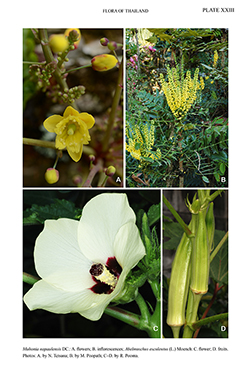e-Flora of Thailand
Volume 14 > Part 2 > Year 2019 > Page 266 > Malvaceae > Abelmoschus
3. Abelmoschus esculentus (L.) Moenchwfo-0000510862
Methodus: 617. 1794; Wight & Arn., Prodr. Fl. Ind. Orient. 1: 53. 1834; Hochr., Candollea 2: 86. 1924; S.Y.Hu, Fl. China, fam. 153: 39. 1955; Backer & Bakh.f., Fl. Java I: 435. 1963; Borss.Waalk., Blumea 14: 100. 1966; Sivar. & Pradeep, Malvaceae S. Penins. India: 62. 1996; Y.Tang et al. in C.Y. Wu et al., Fl. China 12: 285. 2007.— Hibiscus esculentus L., Sp. Pl. 2: 696. 1753; Cav., Diss. 3: 168, t. 61 f. 2. 1787; Mast. in Hook.f., Fl. Brit. India I: 343. 1874; Gagnep. in Lecomte, Fl. Indo-Chine. I: 433. 1910. Plate XXIII: C–D.
Accepted Name : This is currently accepted.
Synonyms & Citations :
Description : Annual herb 0.5–2 m tall; stem thick, erect, covered with some stiff simple hairs, glabrescent, often tinged red. Leaves angular or 5–7-lobed, 6–25 by 7–30 cm; lobes triangular, ovate, oblong or lanceolate, base cordate, apex acute, margin coarsely serrate to crenate, glabrescent with scattered short stiff simple hairs on both surfaces; palmately 5–7-nerved. Petiole 5–30 cm long, with a line of short simple hairs on upper side, often tinged red. Stipules filiform, 5–10 mm long. Flower solitary. Peduncle 5–15 mm long, accrescent to 5 cm in fruit. Epicalyx lobes 7–10(–12), linear to lanceolate, 5–17 by 1–2 mm, caducous, densely, covered with appressed simple hairs. Calyx campanulate, 1.5–3 cm long, 2–3 cm in diam., spathaceous, outer surface covered with stiff simple hairs, inner surface sericeous. Corolla yellow with a dark red-purple centre. Petals obovate, 3.5–7 by 3–5 cm, subglabrous. Staminal column 2–3 cm long; filament 0.5–1 mm long; anthers throughout the column. Ovary conical to ovoid, 1–1.5 cm long, sericeous, 5-locular; stigmas discoid, purple. Capsule cylindrical, 10–25 by 1.5–2.5 cm, slightly 5-angular, salcate, beaked, short simple hairy. Seeds many, globose, 3–6 mm in diam., striped, minutely warty, glabrous, white when young, dark brown to grey when mature.
Thailand : Widely cultivated throughout the country.
Distribution : Although the exact origin is unknown, it is thought to have come from Africa, where it has been grown as a crop for centuries. Evidence suggests it was grown in Egypt as long ago as 2,000 BC. It is found in cultivation throughout the tropics.
Ecology : Cultivated.
Vernacular : Krachiap (กระเจี๊ยบ), kra chiap mon (กระเจี๊ยบมอญ), ma khuea thawai (มะเขือทะวาย), ma khuea mon (มะเขือมอญ)(Central); ma khuea muen (มะเขือมื่น), ma khuea lawo (มะเขือละโว้)(Northern).
CommonName : Lady’s finger, Okra.
Uses: Cultivated as a vegetable.

